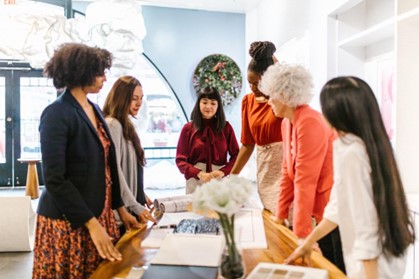Office design is more than just creating a functional workspace. It’s an opportunity to tell a story, to make a statement, and to reflect the values and identity of a company. In the modern business landscape, companies are increasingly recognising that their office environments can serve as powerful tools for shaping their corporate culture, fostering employee engagement, and building a brand identity that resonates with both employees and clients. In this article, we’ll explore the concept of office design as a reflection of corporate values and the ways in which it contributes to building a strong brand identity.
The Importance of Office Design in Brand Building
In a world where competition is fierce, and the battle for talent and clients is ongoing, it’s crucial for organisations to distinguish themselves. Office design has emerged as a strategic element in this endeavour. Here are some key reasons why office design is vital for brand building:
- First Impressions Matter: Your office is often the first physical space that clients, potential employees, and visitors encounter. It sets the stage for their perception of your organisation. A well-designed office can create a positive first impression and communicate professionalism and creativity.
- Reinforcing Brand Values: The physical environment of your office can be a powerful visual representation of your brand’s core values. The design elements you choose can convey messages about your company’s culture, innovation, sustainability, or any other aspect that’s important to your brand identity.
- Boosting Employee Morale: A well-designed office is not just about aesthetics; it’s about creating a space where employees feel comfortable, inspired, and valued. A supportive work environment can lead to higher job satisfaction, engagement, and loyalty among employees.
- Differentiation: In a competitive market, having a distinct and memorable brand identity is crucial. A uniquely designed office can help your organisation stand out and be remembered by clients and potential partners.
- Consistency: Your office design should align with other branding elements, such as your logo, website, and marketing materials. A consistent visual identity reinforces brand recognition and trust.
Elements of Office Design that Reflect Corporate Values
A well-thought-out office design can reflect corporate values in various ways. Here are some essential elements to consider:
Layout and Space Utilisation
The layout of your office can communicate your approach to collaboration, hierarchy, and flexibility. An open floor plan may suggest transparency and accessibility, while private workspaces can reflect a focus on individual concentration and privacy. How you utilise space, from common areas to private offices, speaks to your approach to work and your employees’ needs.
Color Palette
Colours evoke emotions and have a psychological impact. The choice of colours in your office design can communicate specific feelings and values. For instance, blue can convey trust and professionalism, while green may symbolise sustainability and growth. The colour palette should align with your brand’s message and identity.
Furniture and Furnishings
The type of furniture and furnishings you choose can reflect your company’s values. Ergonomic furniture can demonstrate a commitment to employee well-being, while modern, minimalist design can suggest innovation and simplicity. Sustainable materials and practices in furniture selection underscore environmental responsibility.
Branding Elements
Integrate branding elements into your office design. This includes displaying your company’s mission and values on the walls, incorporating your logo in prominent locations, and using signage that reflects your brand identity. These elements serve as constant reminders of your company’s core principles.
Lighting
Lighting plays a significant role in creating an atmosphere in the office. Natural light can promote energy and productivity, while softer, warmer lighting can create a cosy and inviting environment. Consider the type of lighting that best aligns with your brand values and the atmosphere you want to convey.
Art and Decor
Art and decor in the office can be used to express creativity and individuality. The choice of artwork and decor elements should be aligned with the company’s values and the message it wants to convey. For instance, showcasing local artists may signal a commitment to community and creativity.
Sustainability Initiatives
Incorporating sustainable design elements, such as energy-efficient lighting, recycled materials, and green spaces, reflects a commitment to environmental responsibility. Sustainability aligns with a value system that prioritises corporate social responsibility.
If all these sound complex, you can always have the best office interior designers to help build the right office space that marks a significant place in the market you operate in.
Real-World Examples of Office Design Reflecting Corporate Values
Numerous companies have successfully integrated their values into their office design. Let’s look at a few real-world examples:
-
Google
Google’s office spaces are renowned for their creativity, playfulness, and focus on employee well-being. The office design reflects Google’s commitment to innovation and a fun, collaborative work culture. From colourful and open work areas to quirky meeting spaces, Google’s office environments are a tangible expression of their brand values.
-
Airbnb
Airbnb’s office spaces are designed to reflect the company’s core value of “Belong Anywhere.” The office designs incorporate elements from different cultures, fostering a sense of global inclusivity. Each office location has a unique theme and is modelled to resemble a different Airbnb listing, embracing diversity and uniqueness.
-
Patagonia
Known for its commitment to environmental responsibility, Patagonia’s office design incorporates sustainable elements such as reclaimed wood, energy-efficient lighting, and indoor plants. The office spaces embody the brand’s values and mission to “Build the best product, cause no unnecessary harm.”
-
Tesla
Tesla’s office spaces align with its mission of sustainability and innovation. These spaces incorporate cutting-edge technology, electric vehicle charging stations, and sustainable materials. The design reflects Tesla’s core values of environmental responsibility and technological advancement.
-
Salesforce
Salesforce’s office design reflects its dedication to corporate social responsibility and equality. The company’s workspaces are known for inclusivity and sustainability, featuring gender-neutral restrooms, green building practices, and an emphasis on community involvement.
The Role of Employee Feedback in Office Design
To ensure that office design effectively reflects corporate values, employee feedback is invaluable. Employees are not just users of the space; they are stakeholders in the organisation’s mission and culture. Here’s how employee feedback plays a crucial role:
- Alignment with Values: Employee feedback can provide insights into how well the office design aligns with the company’s stated values. It offers an opportunity to assess whether the design is perceived as authentic and meaningful.
- Well-Being and Comfort: Employees can provide feedback on the comfort and functionality of the office space. This includes assessing the ergonomic aspects of furniture, lighting, and noise levels. A comfortable workspace promotes well-being and productivity.
- Cultural Fit: Employee feedback can reveal whether the office design resonates with the cultural values of the organisation. It’s an opportunity to gauge whether employees feel a sense of belonging and connection with the space.
- Suggestions for Improvement: Employees often have practical suggestions for improving the office environment. They can identify areas where the design may fall short in terms of supporting their work and the company’s values.
The Future of Office Design and Brand Identity
As office design continues to evolve, the future promises even more exciting possibilities for aligning design with brand identity:
- Personalisation: Office design will become more personalised, allowing employees to customise their workspaces to match their preferences and work styles. This promotes a sense of ownership and individuality while aligning with the company’s values of empowerment.
- Flexibility: The design of future offices will prioritise flexibility to accommodate changing work styles, including remote and hybrid work. This reflects values of adaptability and a commitment to employee well-being.
- Innovation Centers: Companies will increasingly incorporate innovation centres within their office spaces. These areas will foster creativity, experimentation, and reflection of a company’s values of continuous improvement and innovation.
- Well-Being Focus: The design of office spaces will prioritise employee well-being, with features such as wellness rooms, natural light, and green spaces. This reflects a commitment to the values of health and holistic employee support.
Conclusion
Office design is an essential tool for shaping corporate values and building a brand identity that resonates with employees, clients, and partners. It offers a physical representation of an organisation’s mission, culture, and core principles. As companies continue to recognise the significance of office design in their success, they will prioritise creating work environments that authentically convey their values, fostering stronger brand identities and a competitive edge in the business world.





